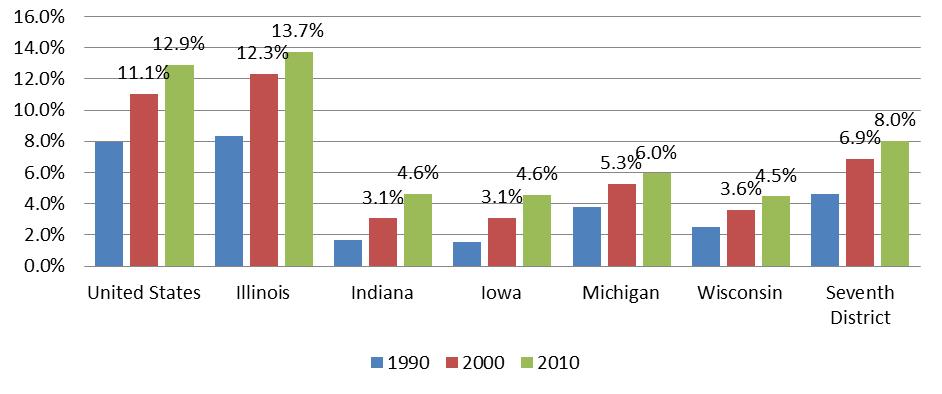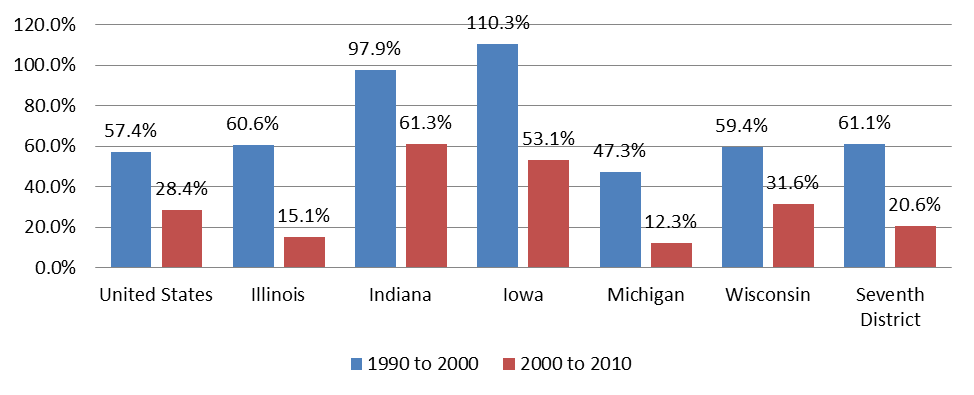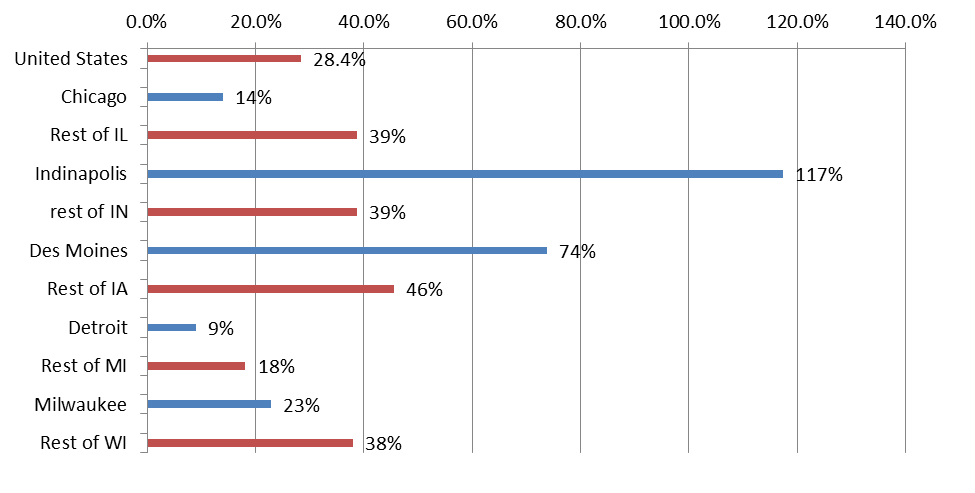New Issues in Immigration Research
Over the past few decades, U.S. immigrant groups have abandoned a longstanding pattern of settling predominantly in major urban areas. Rather, their residential areas have expanded and diversified to rural locales and smaller metropolitan areas, along with the traditional settlement areas in big cities such as New York, Chicago, Los Angeles, Miami, and Boston. And within these big cities, immigrants are also now living in larger numbers in suburban communities.
In the 7th District, which includes most of Illinois, Indiana, Iowa, Michigan, and Wisconsin, immigrants are expanding their presence from the bigger cities to their peripheries and into rural areas. Immigrants are attracted by job growth, more affordable housing, better performing schools, and safer neighborhoods (Wilson and Singer, 2011).1 This demographic transformation has heightened racial, ethnic, and linguistic diversity throughout the Seventh District.While the geographical expansion of the immigrant diaspora offers more employment opportunities and greater access to goods and services, immigrants also face greater uncertainties. Communities that are unaccustomed or unprepared for inflows of foreigners sometimes view newcomers as a drain on resources and a threat to native employment.
For economists, these changes raise questions about the effects of immigration on local communities. Traditionally, economists have largely focused on the impact of inflows of immigrants on labor markets. However, we now look at other socioeconomic outcomes and issues in receiving localities. The pressure on local housing prices is one such outcome. This issue has become all the more important in the aftermath of the recent housing crisis, the worst in U.S. history. Adverse effects of the crisis have been widespread but not evenly distributed, neither geographically nor across different racial and ethnic groups. Researchers are seeking to understand how the increasingly widespread immigrant communities are navigating the crisis, as well as the role of immigrant housing demand in the housing market overall.2
In this blog, I discuss the changes in the foreign-born population in the Seventh District during the first decade of the 2000s and review new research on immigration from a workshop organized by the Journal of Regional Sciences (JRS) held at the Federal Reserve Bank of Chicago on November 7–8, 2011. The workshop brought together researchers to discuss new frontiers and directions for the study of immigration. A special issue of the JRS, to be published in February 2013, compiles selected contributions from the workshop.
Foreign-born in the Seventh District
The foreign-born demographic accounts for 13% of the U.S. population (Chart 1), and is expected to provide for most of the population gains in the coming decades (not shown) (Passel and Cohn, 2008).3 In our District, 8% of the population is foreign born. Illinois, in particular, has remained an exceptionally strong magnet for immigrants among District states, with 14% of its population foreign born.
With the Great Recession and accompanying high unemployment rates in the first decade of the current century, the growth rate in the immigrant population in the Seventh District slowed from the rapid influx seen in the 1990s, the largest on record (Chart 2). This reflected the slowing national trend. Chart 3 distinguishes the growth in foreign-born populations in each Seventh District state’s largest metropolitan area relative to the rest of the state. The slower growth in the foreign-born population in the Chicago metropolitan area relative to the rest of the state is consistent with research that has noted the ongoing outward sprawl of this metropolitan area (Johnson, 2007).4 In large metropolitan areas where economic growth has been lagging the state’s economic growth and where unemployment has been relatively high, the increase in the foreign-born population has tended to lag that for the remainder of the state. This is also the case for Milwaukee and Detroit (Chart 3).5
Chart 1. Foreign born as a percent of total population

Chart 2. Percent change in foreign born population: 1990 to 2000, 2000-2010

Chart 3. Percent change foreign born, metro area / rest of state, 2000-2010

Implications for localized markets: New research findings
Research areas such as those examined in the JRS offer useful insights into the potential roles of immigrants in local housing markets, neighborhood characteristics, and local businesses’ survival and growth.
Among other pertinent findings of the studies in the JRS, one article finds that in an area in Europe that experienced a housing boom during the 2000s, about one-third of the increase in house prices and in the available housing stock between 2000 and 2010 can be explained by immigration. (Saiz, 2007, estimated similar effects for the U.S).6 As the stock of housing is often owned by natives to a large degree, significant shifts in wealth are identified as a possible outcome of large-scale immigration.
Another article found that immigrants can have both positive and negative impacts on communities. On the one hand, the paper identified a positive effect of cultural diversity on average housing prices (e.g., ethnic food restaurants). But other costs associated with immigrant agglomeration may offset some of the positive effects.
Another article looks at whether a high population density of immigrants generates negative outcomes such as increased crime. The analysis reveals that the presence of a large population of immigrants, especially if from the same country, generates much lower crime rates. Accordingly, despite some public perception to the contrary, “enclaves” of immigrants may actually provide an effective way to reduce crime.
Impact on firms
The survival of firms and retention of employees are especially important during times of economic slowdown. One article examines whether businesses lay off native-born workers in response to an abundance of (potentially lower-cost) immigrant workers. The study shows that cities with large inflows of immigrants absorb them by significantly increasing the number of business establishments. The expansion of the number of firms is consistent with the lack of any negative effect of immigrants on wages identified in the literature (see, e.g., Card, 2009).7 Other research presented in the JRS uses a unique database of immigrants matched to firms in Georgia. It analyzes whether hiring “undocumented” workers increases the probability of survival of a firm. It shows that these firms save on costs (i.e., labor) and have a significantly lower probability of exiting the market, especially if they are in sectors that produce labor-intensive goods.
New approach to studying impact of immigration
The new approach to the study of immigration’s effects acknowledges the diversity (heterogeneity) of skills that immigrants bring. The picture emerging from the studies in the JRS is that the local amenities of cities may be significantly affected by the presence of immigrants. Immigrants bring to urban areas important dynamics of population growth which affect housing values, among other things, and which have wealth implications for the entire community.
The findings in the JRS articles on immigrants and firms are consistent with previous findings that immigration has the potential to stimulate investment and increase the size of the economy without crowding out native workers in some instances. The analysis of undocumented immigrants, their specific characteristics, and their impact on firms has only recently become possible with new and unique firm-level data and offers an interesting avenue of research to be developed.
Footnotes
1 Wilson, Jill H. and Audrey Singer (2011). “Immigrants in 2010 Metropolitan America: A Decade of Change,” Brookings, Metropolitan Policy Program at Brookings, State of Metropolitan America/Immigration, October 2011
2 e.g., for a study of Hispanic neighborhoods in Chicago and the foreclosure crisis see, Martinez, Martha A. (2009), “The Housing Crisis and Latino Home Ownership in Chicago,” Institute for Latino Studies, University of Notre Dame, October 2009.
3 Passel, J. and D’Vera Cohn (2008). U.S. Population Projections: 2005-2050,” Pew Research, available online.
4 Johnson, Kenneth M. (2007). “Demographic Trends in Metropolitan Chicago at Mid-Decade,” Working Papers on Recreation, Amenities, Forests and Demographic Change. No. 6.
5 For details on the ethnic and immigrant concentration in smaller geographies see University of Chicago Map Collection for Chicago Census Maps depicting neighborhood level data on the ethnic diversity and location concentration patterns in Chicago. For similar depiction of ethnic/immigrant neighborhoods in Detroit (e.g., Corktown/Irish; Greektown; Dearborn/Arab; and Mexican town), see here.
6 Saiz, Albert (2007). “Immigration and housing rents in American cities,” Journal of Urban Economics, Elsevier, vol. 61(2), pages 345-371, March.
7 Card, David (2009). “Immigration and Inequality,” American Economic Review, Papers and Proceedings, 99, 1–21.








